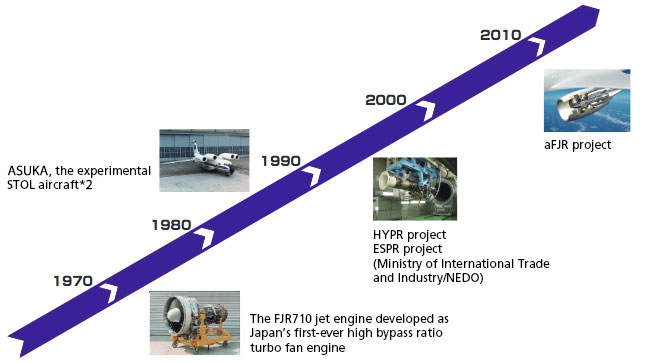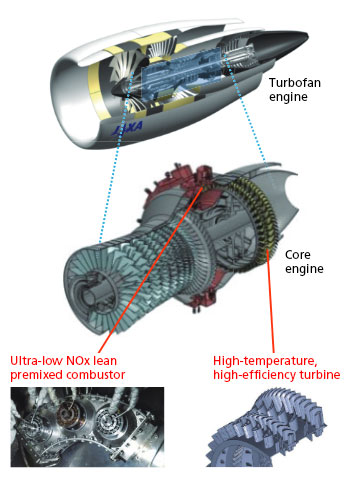About us
JAXA Aviation helps to create a safer and more prosperous society with aeronautics-related research and development activities.
FLIGHT PATH No.22 | 2018 WINTER
JAXA's Aspirations behind the Fourth Mid-to-long-term Plan
Reflecting on ideas discussed by the strategic working group
In pursuit of broader social implementation Accelerating core engine technology research

YAMANE Takashi
Project Manager, En-Core Pre-project team
Core engine is identified as a key focus area in the Fourth Mid-to-long-term Plan.
JAXA has many years of accumulated research that started in the days of the National Aerospace Laboratory of Japan (NAL). The NAL's Fan Jet Research (FJR) project is a representative example of efforts in the area of engines, and JAXA has continued to build on this work by pursuing research and development along a roadmap that includes Green Engine Technology Research and the advanced Fan Jet Research (aFJR) project.
Engine research follows a number of stages that begin with basic research, followed by more advanced work to mature the technology, before it can finally become a project. An engine is produced by piecing together various research findings related to component technologies. With regard to combustors, for example, we have been conducting research and development of lean premixed combustion technology*1. The manufacturers we have been working with in this research wanted to enhance their technological capabilities in other core engine components such as compressors and turbines as well, in addition to combustors. So we decided to make a proposal to the strategic working group for addressing these core engine technologies in our Fourth Mid-to-long-term Plan. The timing was just about right.

History of aircraft engine research and development passed on to JAXA's Aviation Technology Directorate
We've been pursuing engine-related research and development activities in collaboration with external partners since the time of the FJR project*3. In the Fourth Mid-to-long-term Plan, we will be making closer collaborative efforts with external partners, including domestic jet engine manufacturers, to push forward with the research and development of core engine technologies, with an eye to boosting the international competitiveness of Japan's aviation industry.
What are the goals of your core engine research?
In the past, there were government-led projects to research supersonic aircraft engines called HYPR and ESPR, as well as to develop the so-called ECO engine. Currently, however, there is no plan underway in Japan to create a whole engine for a commercial aircraft. That's why I believe JAXA should take the initiative and launch a project to put these pieces together.

>En-Core: core engine technology demonstration pre-project
By joining forces with manufacturers, we can amass combustor and turbine technologies to establish a technological foundation that is just a step away from practical application. We will then hand over the technologies to the manufacturers, who will only have to combine the results to create an engine system. On our part, we can use these technologies as a foundation for conducting new research.
While it is possible to further pursue the Propulsion Research Unit's work on combustor and turbine technologies by developing them individually, I believe we can engage in the kind of technological development that will help boost the Japanese industry's ability to compete globally by doing all the work with a view to producing a whole engine in the future. One specific example of our initiatives along this line is called the “En-Core Pre-project,” in which we perform demonstration of the core engine technology. En-Core stands for “Environmentally Compatible Core Engine.” In this effort, we will tackle two themes: an ultra-low NOx lean premixed combustor and a high-temperature, high-efficiency turbine.
- *1: Technology that can reduce emissions of environmental pollutants such as NOx and smoke while improving fuel efficiency. See FLIGHT PATH No. 13/14 for more information.
- *2: A short takeoff and landing (STOL) experimental aircraft based on the C-1 transport aircraft and powered by FJR710 engines. Used to perform a total of 97 flight tests between 1985 and 1989.
- *3: A project of the then Ministry of International Trade and Industry (now Ministry of Economy, Trade and Industry). The experimental turbofan engine FJR710 was arguably Japan's first high bypass ratio turbofan engine ever developed. It was ultimately used to fly the STOL experimental aircraft “ASUKA.”
JAXA's Aspirations behind the Fourth Mid-to-long-term Plan
Reflecting on ideas discussed by the strategic working group
- Toward broader social implementation, stronger fundamental research base, and creation of new value that provides innovative solutions to existing issues
- Accelerating core engine technology research
- Using integrated simulation technologies to solve complicated multidisciplinary problems
- Building on past research to make silent supersonic passenger aircraft a reality
October 23, 2019